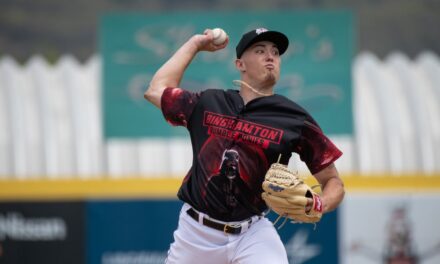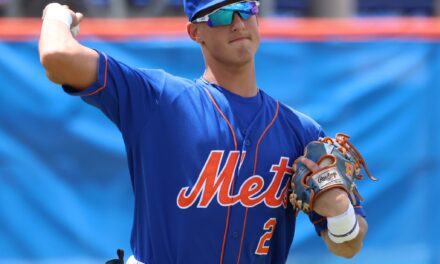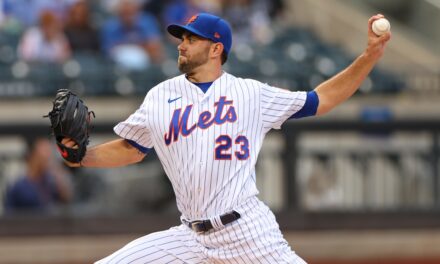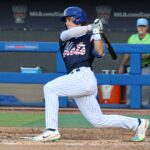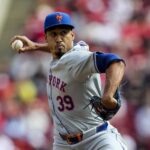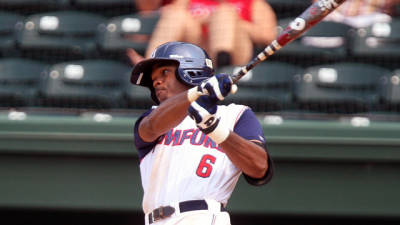
The Mets have some power within their farm system. Their top sluggers include Aderlin Rodriguez, Cory Vaughn, and Travis Taijeron. The Mets have tried to remedy this issue by drafting powerful High School catcher Tomas Nido, top outfielder Brandon Nimmo, as well as trading for Travis d’Arnaud, another catcher with power, and signing Ahmed German Rosario, a shortstop who could produce a lot of power as well. But, when it comes to power bats closer to the Majors, only Vaughn and d’Arnaud stand out, while the rest of the class toil at the lower levels.
As stated two weeks ago in an article about top high school outfielders in the upcoming draft, the farm system has a big when it comes to quality outfielders, with only a few including Brandon Nimmo and Alonzo Harris showing promise.
College bats usually have a lot of polish, and when they work out, they move quickly. Ike Davis is one example of a college power bat that put everything together with a meteoric rise through the system. I asked the readers last week in my article about lefthanded pitchers what draft reports they wanted to read about, and many chose potent college bats and outfielders. Here they are.
The Ones To Know:
3B Kris Bryant, San Diego, Jr, 6’5”, 215 lbs, B/T R/R
Bryant is widely considered the best power bat in the college ranks. He has easy plus power, which Jon Mayo grades as a future 7, meaning he could hit more than 30 home runs annually. With his power being tremendous, his batting could produce a .265 to .280 batting average. He is likely staying in the infield at either first or third base because of below average foot-speed. He is a lock to go within the first 15 picks.
1B/3B DJ Peterson, New Mexico, Jr, 6’1”, 190 lbs, B/T R/R
This college first baseman has a ton of power. After leading his team in his sophomore year with a .419 batting average and 17 home runs, he has hit 12 homer runs thus far with a .397 batting average. He is considered a polished bat, who could hit more than .290 with 20+ home runs annually, and is considered a patient hitter, who isn’t afraid to take a walk. While he can play at either corner of the infield, he has average foot speed, meaning he would not be a viable player for outfield.
OF Phillip Ervin, Samford, Jr, 5’11”, 190 lbs, B/T R/R
Ervin might be one of the most intriguing players in the draft. He is a legitimate power-speed threat; earning MVP honors in the Cape Cod League last summer with a .323 average, 11 homeruns, and 10 steals. According to Mayo, he is a plus-plus runner who can stick in center field, but has average power, and an above-average bat. His statistics speak for themselves, showing an ability to play above his tools, and be a legitimate game-changer with his speed.
OF Austin Wilson, Stanford, Jr, 6’5” 245 lbs, B/T R/R
After turning down the Cardinals in the 12th round in the 2010 draft, Highly touted Wilson went to Stanford. Considered an athlete, Wilson projects to have at least a plus hit tool, and above average raw power. What concerns people are the low propensity of success from Stanford hitters in pro ranks, and his tendency to strike out. He has an average run tool, and is projected to be an above average right fielder, should he reach his potential. He will be an interesting player to watch develop.
OF Aaron Judge, Fresno St, Jr, 6’7” 240 lbs, B/T R/R
Aaron Judge is known for his plus-plus raw power, which grades out as a 70 on the 20-80 scale. That can measure out to more than 30 home runs annually. The problem though, is that it doesn’t show up in games. This year with Fresno state, he has 7 home runs so far, and a .347 batting average in 37 games. Judge is a patient hitter, who projects to be a peak .280 hitter in the majors. When all is said and done, Judge could be a powerful right fielder and in the middle of a lineup.
Keep An Eye On:
3B/OF Eric Jagielo, Notre Dame, Jr, 6’3” 215 lbs, B/T L/R
Jagielo has definitely opened eyes in the Cape Cod league, hitting .291 and finishing second in the league with 13 home runs. He has the potential to hit around .270 – .280, and hit 25+ home runs annually. Not enough people think he can stay at third, but his bat could be just fine on the other side of the diamond, or in left field.
OF Michael Lorenzen, Cal State Fullerton, Jr, 6’3”, 195 lbs, B/T R/R
Has 5 tools, but they haven’t played up in games. He is very good defensively in center field. Can hit with average bat, and average raw power. His arm is plus, reaching mid to high 90’s as Fullerton’s closer.
1B/OF Brian Ragira, Stanford, Sr, 6’2” 200 lbs, B/T R/R
One of the more intriguing advanced bats, there is above average hit tool and power in bat, but it has not shown up in games. Another Stanford bat, there are certain stigmas, and, honestly the fact that he is a senior isn’t helping his case, either. He does have an average run tool, and can play either side of the outfield in addition to first base.
2B/OF Jacoby Jones, Louisiana State University, Jr, 6’3” 205 lbs, B/T R/R
Jones is an enigma, winning the Cape Cod League home run derby last summer, and showing he could be a plus runner, but he has a lot of issues with contact. His tools in general, average hit, above average power, plus run, above average arm, and above average fielding suggest he’s a great athlete, and has the talent for the first round. His performance in college though, says otherwise.
Hunter Renfroe, Mississippi State, Jr, 6’1”, 210 lbs, B/T R/R
Hunter Renfroe is an intriguing bat to say the least. As of April 21st, Renfroe has hit .407 with 13 home runs for Mississippi State, and has improved considerably from the raw player he started out as entering college. He has at least above-average raw power, but there is concern about some swing-and-miss to his game. He’s an above-average runner, with a plus arm, and could fit very well in right field.
Here’s a Home Run Montage they put together of Renfroe:
[iframe]<iframe width=”420″ height=”275″ src=”https://www.youtube.com/embed/7_6SuD5df_E” frameborder=”0″ allowfullscreen></iframe>[/iframe]
My Thoughts:
While I am very intrigued by all of these college bats, I still look at DePodesta’s tendency to draft young and toolsy high school players, and doubt that he will pick a college player. But, if they deviate from the plan and go for a college outfielder, my main hope is to draft Phillip Ervin as our number one choice. He plays above his tools, and is an amazingly dynamic player. The Mets draft excellent athletes, and despite his stocky frame, Ervin plays like one. It is honestly a slight overdraft, but in my eyes, it is definitely worth it. As well, Renfroe intrigues me as a possible future right fielder with a lot of power, one hope is to draft him in the rounds 2-4.
I use caution, though, because College players have a similar rate of failure as High School Players in the first round, and I can cite many examples of failure from the college ranks, just as you can with high school players.
Here’s a video of Ervin hitting twice in a game where he went 4 for 4 in the Cape Cod League:
[iframe]<iframe width=”420″ height=”275″ src=”https://www.youtube.com/embed/crq-Tsijh-Q” frameborder=”0″ allowfullscreen></iframe>[/iframe]
In case you missed the, please check out my previous draft coverage:
And as always, I welcome questions and feedback about the draft coverage. As well, tell me what interests you, and what I should cover next:
What would you like me to cover next?
Right Handed Pitchers
Catchers
Shortstops
Opinion of the draft and success
Individual players (state below)
Back to Minor league analysis, kid.
Enjoy!

